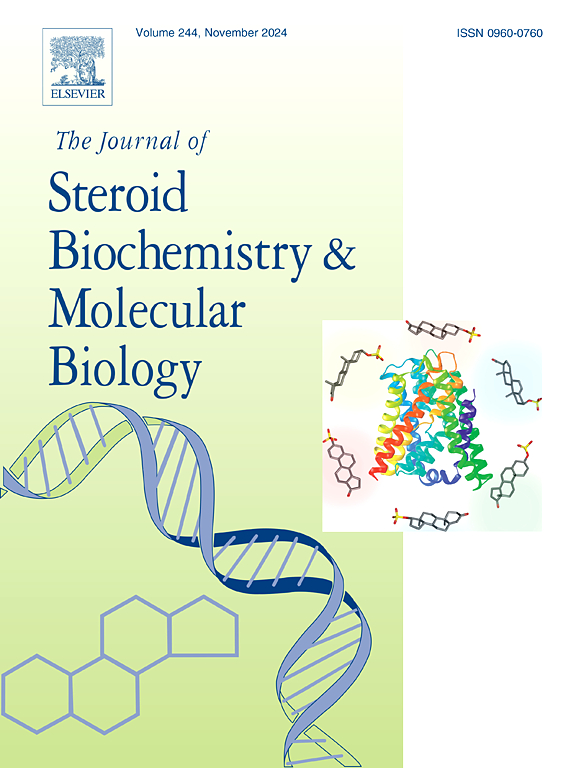Protopanaxadiol synergizes with glucocorticoids to enhance the therapeutic effect in adriamycin-induced nephrotic syndrome
IF 2.7
2区 生物学
Q3 BIOCHEMISTRY & MOLECULAR BIOLOGY
Journal of Steroid Biochemistry and Molecular Biology
Pub Date : 2024-10-22
DOI:10.1016/j.jsbmb.2024.106628
引用次数: 0
Abstract
To date, glucocorticoids remain the mainstay of treatment of nephrotic syndrome (NS). However, serious side effects and development of drug-resistance following long-term use limit the application of glucocorticoids. Protopanaxadiol (PPD) possesses activity of dissociating transactivation from transrepression by glucocorticoid receptor (GR), which may serve as a potential selective GR modulator. However, steroid-like effects of PPD in vivo are unclear and not defined. How to translate PPD into clinical practice remains to be explored. The current study explored the renoprotection and potential mechanism of PPD and its combination with steroid hormones using adriamycin-induced NS rats. Adriamycin was given intravenously to rats to induce nephropathy. The determination of proteinuria, biochemical changes and inflammatory cytokines were performed, and pathological changes were examined by histopathological examination. Immunostaining and PCR were used to analyze the expression of interesting proteins and genes. The results showed that PPD, alone and in combination with prednisone, efficiently alleviate the symptoms of NS, attenuate nephropathy, improve adriamycin-induced podocyte injury by reducing desmin and increasing synaptopodin expression. In addition, the combined treatment reduced the expression of NF-κB protein and mRNA, as well as cytokine levels, and yet increased the expression of GR protein and mRNA. PPD modulated the transactivation of GR, manifested as repressing TAT, PEPCK and ANGPTL4 mRNA expressions mediated by GR. Meanwhile, PPD inhibited elevation of blood glucose and immune organ atrophy induced by prednisone. In summary, PPD increases the therapeutic effect of prednisone in NS while effectively prevents or decreases the appearance of side effects of glucocorticoids.
原人参皂苷与糖皮质激素协同增强阿霉素诱导的肾病综合征的治疗效果
迄今为止,糖皮质激素仍是治疗肾病综合征(NS)的主要药物。然而,长期使用糖皮质激素会产生严重的副作用和耐药性,这限制了糖皮质激素的应用。原人参二醇(PPD)具有使糖皮质激素受体(GR)的反式激活与反式抑制分离的活性,可作为一种潜在的选择性GR调节剂。然而,PPD在体内的类固醇样作用尚不明确,也没有界定。如何将 PPD 转化为临床实践仍有待探索。本研究以阿霉素诱导的NS大鼠为研究对象,探讨了PPD及其与类固醇激素联用的肾保护作用和潜在机制。大鼠静脉注射阿霉素诱发肾病。对大鼠的蛋白尿、生化变化和炎性细胞因子进行测定,并通过组织病理学检查对病理变化进行检测。免疫染色和 PCR 被用来分析相关蛋白质和基因的表达。结果表明,PPD单独或与泼尼松联合使用可有效缓解NS的症状,减轻肾病,并通过减少desmin和增加突触素的表达来改善阿霉素诱导的荚膜细胞损伤。此外,联合治疗还能降低 NF-κB 蛋白和 mRNA 的表达以及细胞因子的水平,同时提高 GR 蛋白和 mRNA 的表达。PPD 可调节 GR 的转录活化,表现为抑制 GR 介导的 TAT、PEPCK 和 ANGPTL4 mRNA 的表达。同时,PPD 还能抑制泼尼松引起的血糖升高和免疫器官萎缩。总之,PPD能提高泼尼松对NS的治疗效果,同时有效预防或减少糖皮质激素副作用的出现。
本文章由计算机程序翻译,如有差异,请以英文原文为准。
求助全文
约1分钟内获得全文
求助全文
来源期刊
CiteScore
8.60
自引率
2.40%
发文量
113
审稿时长
46 days
期刊介绍:
The Journal of Steroid Biochemistry and Molecular Biology is devoted to new experimental and theoretical developments in areas related to steroids including vitamin D, lipids and their metabolomics. The Journal publishes a variety of contributions, including original articles, general and focused reviews, and rapid communications (brief articles of particular interest and clear novelty). Selected cutting-edge topics will be addressed in Special Issues managed by Guest Editors. Special Issues will contain both commissioned reviews and original research papers to provide comprehensive coverage of specific topics, and all submissions will undergo rigorous peer-review prior to publication.

 求助内容:
求助内容: 应助结果提醒方式:
应助结果提醒方式:


